We woke up to a sunny, hazy day in Huế. We got ready and went downstairs to our accommodation’s lobby where they served us a homemade breakfast. Our host arranged for our bikes to be delivered and then we were on our way to the Imperial Citadel.

 Huế was established as the capital of unified Vietnam in 1802, becoming the political, cultural and religious centre under the Nguyen Dynasty until 1945. The Kinh Thanh (Imperial Citadel) was built between 1804 and 1833. It was the administrative centre of southern Vietnam during the 17th and 18th centuries CE.
Huế was established as the capital of unified Vietnam in 1802, becoming the political, cultural and religious centre under the Nguyen Dynasty until 1945. The Kinh Thanh (Imperial Citadel) was built between 1804 and 1833. It was the administrative centre of southern Vietnam during the 17th and 18th centuries CE.
The Citadel has distinct sections. The Imperial Enclosure and Purple Forbidden City formed the epicentre of Vietnamese royal life. On the southwestern side were temple compounds, while there were residences in the northwest, gardens in the northeast and, in the north, the Mang Ca Fortress, which still functions as a military base.
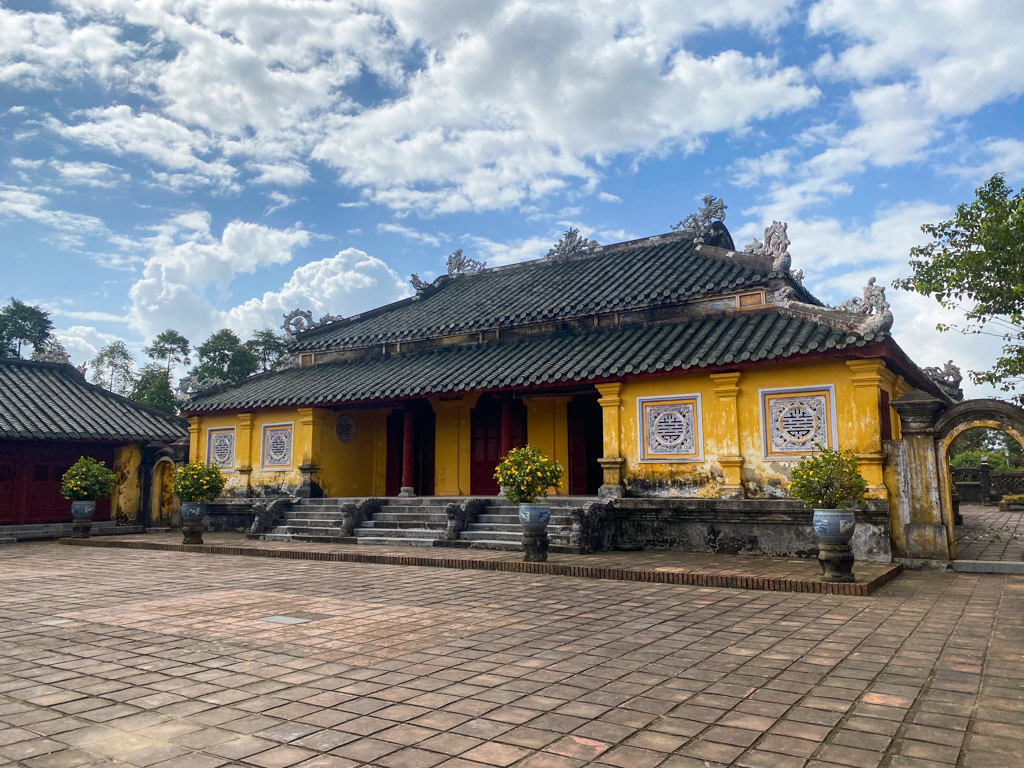 The Imperial Enclosure or Imperial City is a citadel within a citadel. It houses the emperor’s residence, temples and palaces, and the main buildings of the state. The original enclosure would’ve had so many buildings, but it was badly bombed during the French and American wars resulting in only 20 of its 148 buildings surviving.
The Imperial Enclosure or Imperial City is a citadel within a citadel. It houses the emperor’s residence, temples and palaces, and the main buildings of the state. The original enclosure would’ve had so many buildings, but it was badly bombed during the French and American wars resulting in only 20 of its 148 buildings surviving.
The first structure we encountered was the grand Ngo Mon Gate. It’s the principal entrance to the Imperial Enclosure. On top of the gate is Ngu Phung (Belvedere of the Five Phoenixes) and on its upper level is a huge drum and bell.
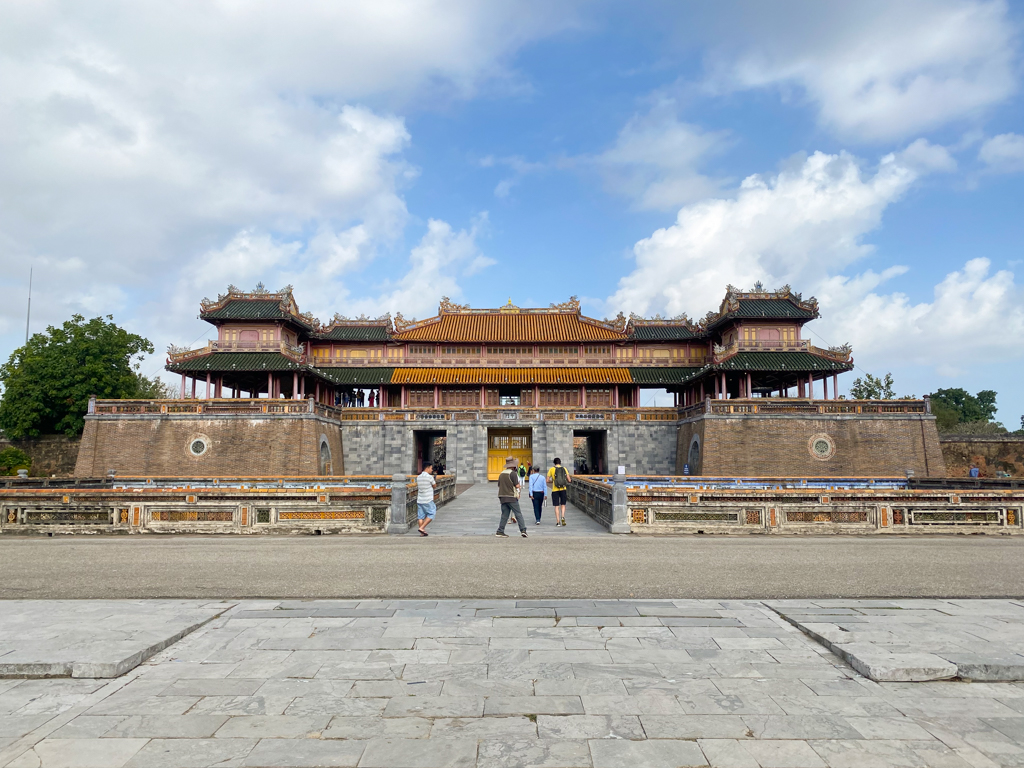
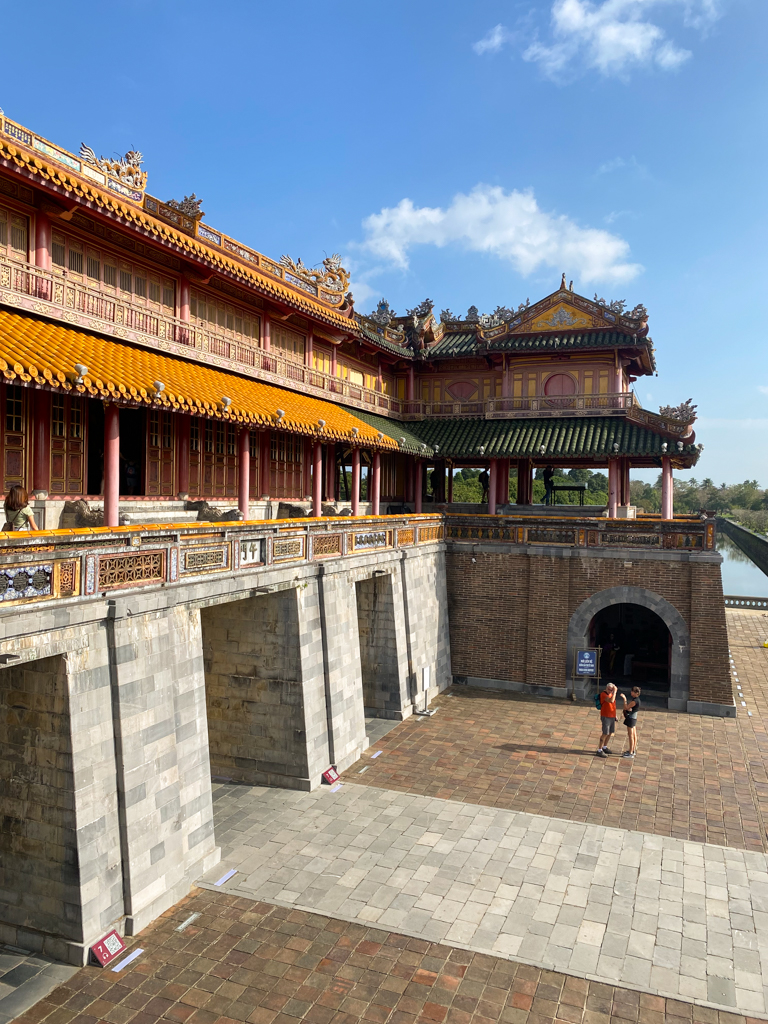
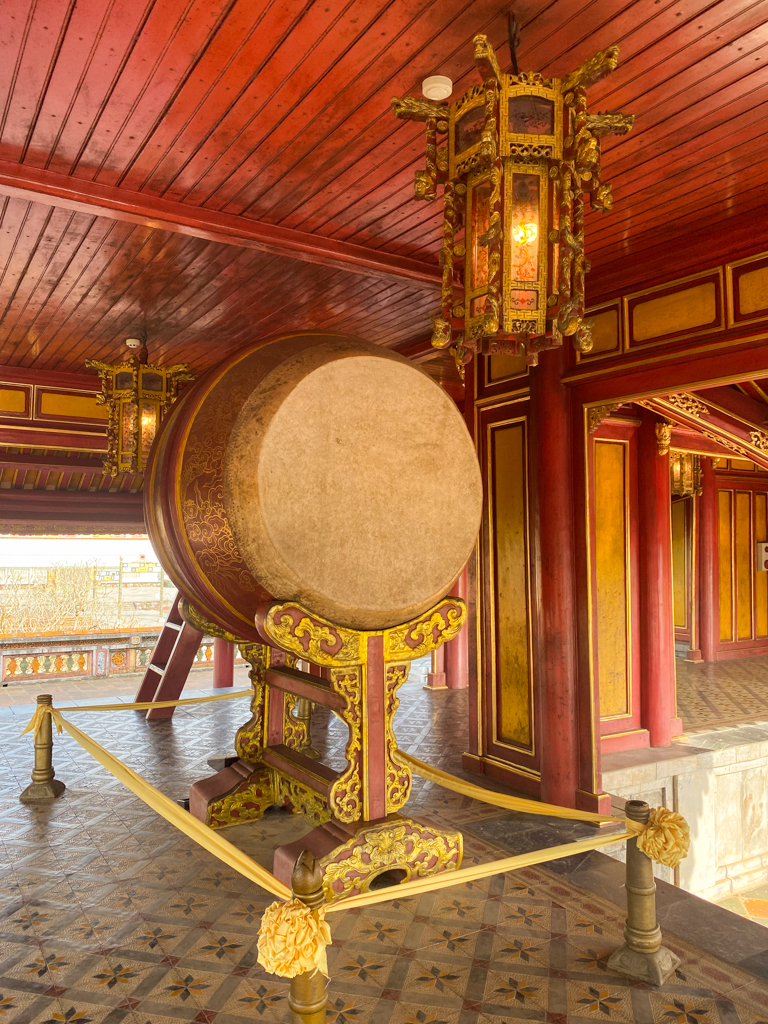
Once we passed through the gate we could see the Thai Hoa Palace ahead of us. This 1803 palace is a spacious hall with an ornate timber roof supported by 80 carved and lacquered columns. It was used for the emperor’s official receptions and important ceremonies. You’re not allowed to take photos inside but, in any case, it was undergoing restoration during our visit (as of January 2024) so we didn’t get to see inside.
We then visited the Halls of the Mandarins. Located immediately behind Thai Hoa Palace, on either side of a courtyard, are some rooms, or halls. Mandarins used these halls as offices and to prepare for court ceremonies.
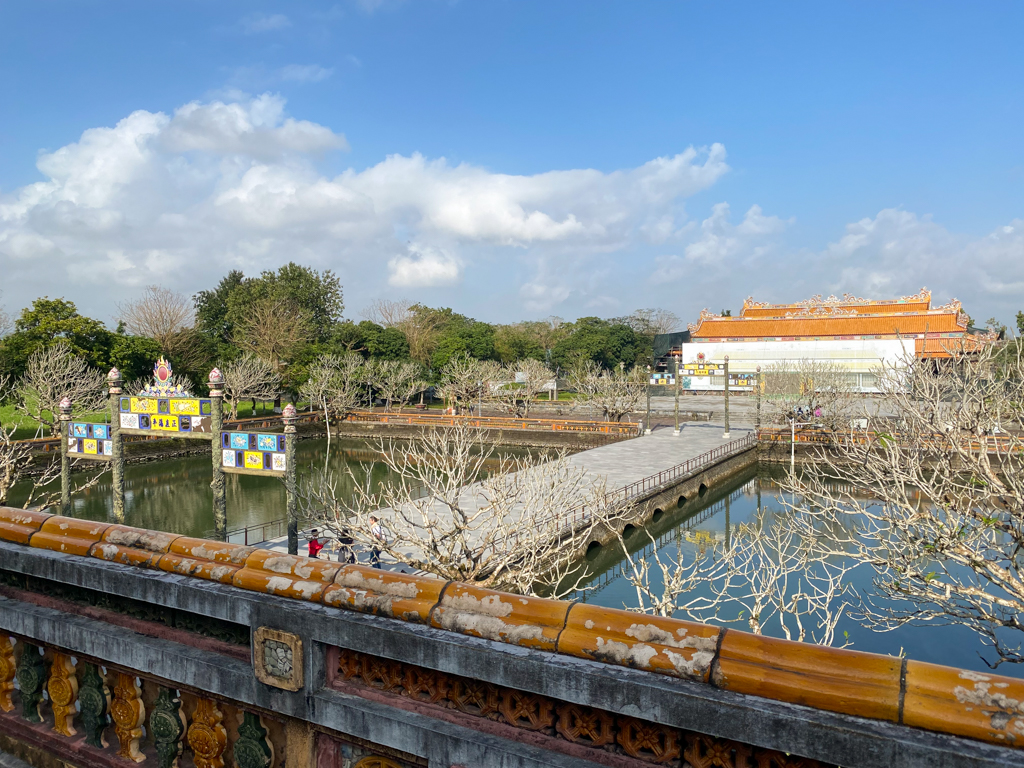
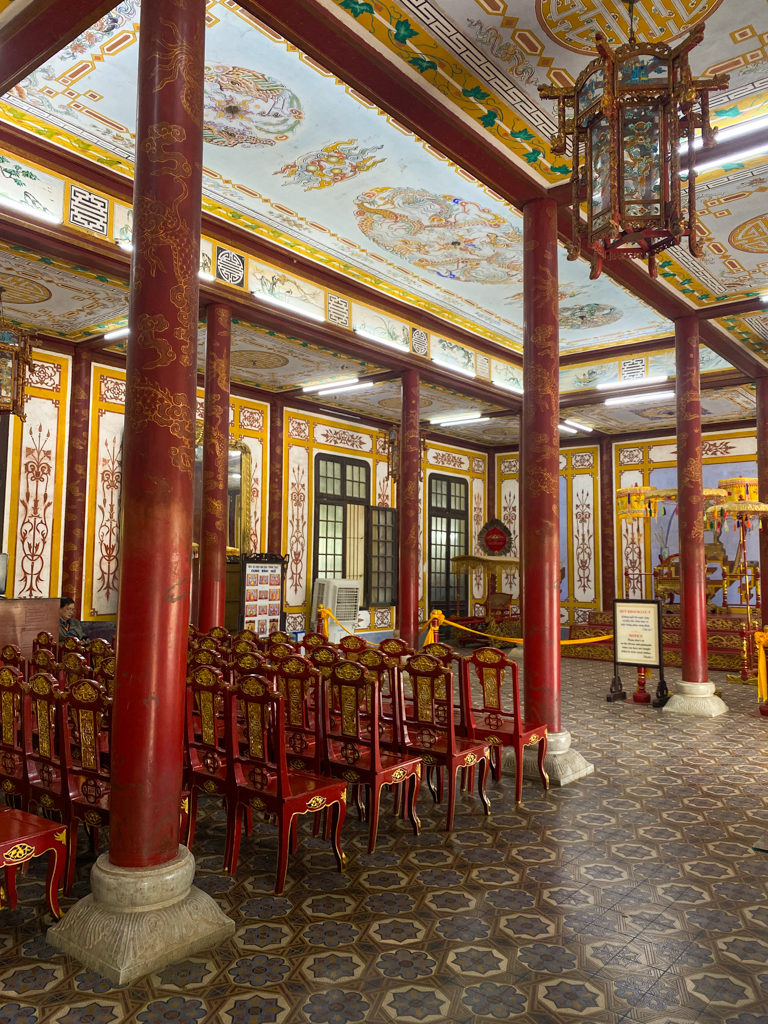
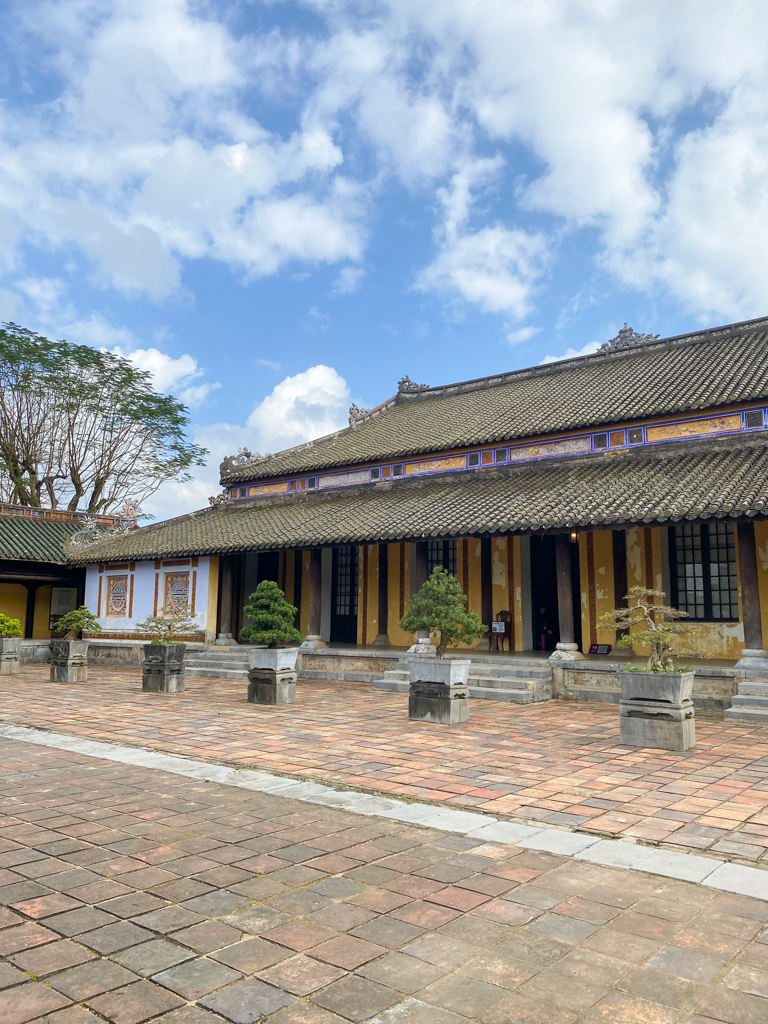
To the east of the main axis of the complex is The Royal Theatre. It’s a beautiful building, raised quite a bit above the ground. It’s still used as a theatre today and you can watch performances here twice a day for an additional fee.
Behind the Halls of the Mandarins is a large open space where the Can Chanh Palace once stood. It’s now ruined, but two long, symmetrical galleries on either side of the area have been restored. These are really beautiful, with deep red columns and doorways, and carving details highlighted in gold. I absolutely loved walking through these galleries.
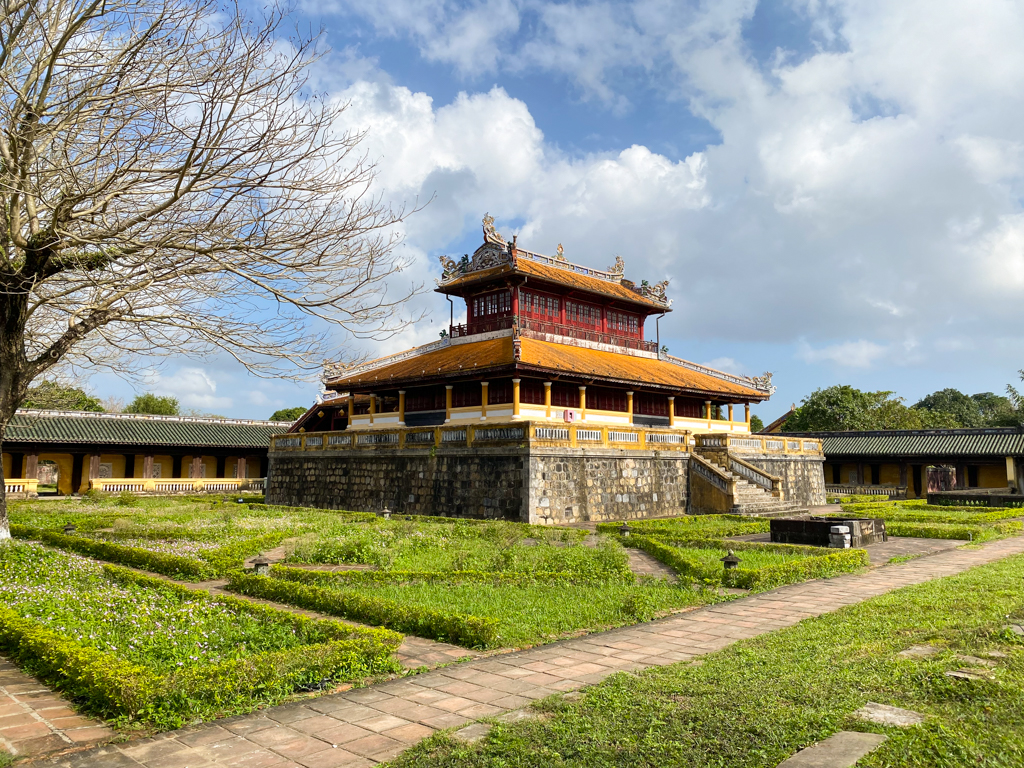
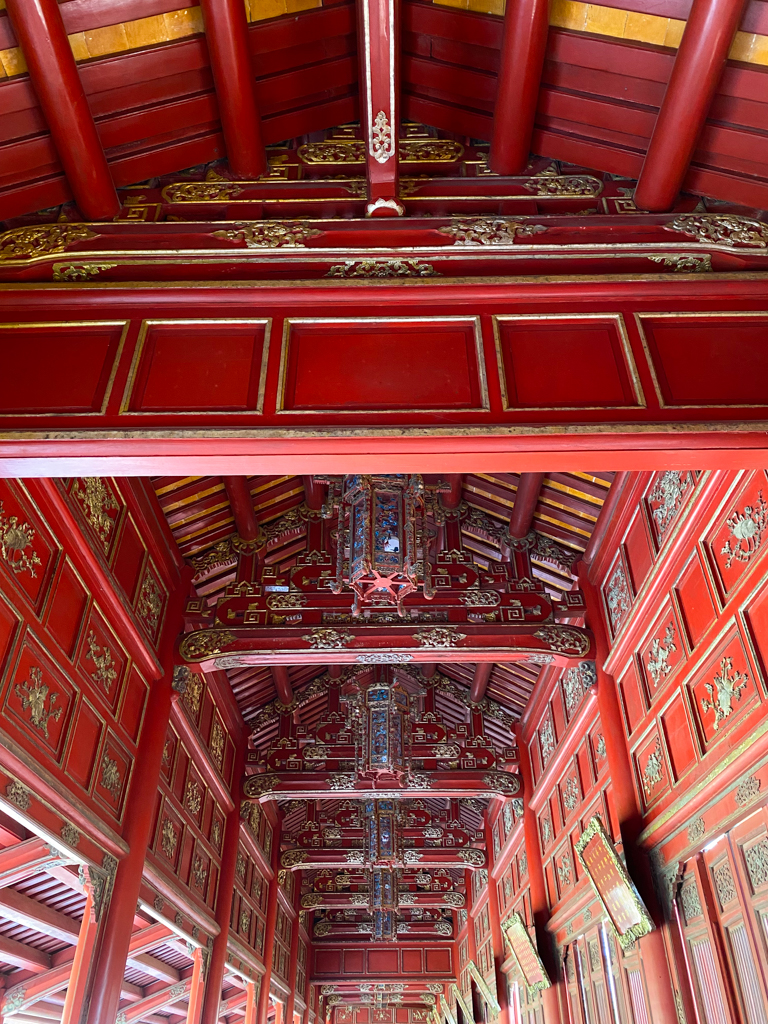
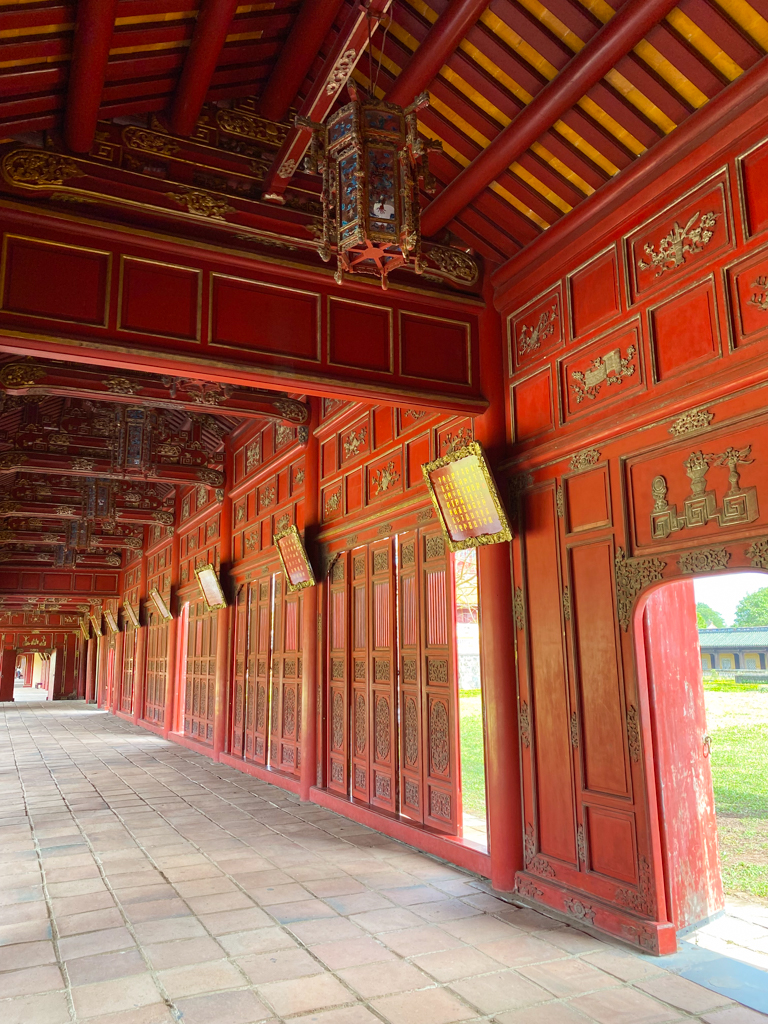
During our visit, we noticed a very large and glamorous building at the back of the complex undergoing restoration work. Constructed between 1921 and 1923 under the reign of King Khai Dinh, this opulent residence served as the monarch’s primary abode. It’s called the Kien Trung Palace and exhibits a fusion of French, Italian, and traditional Vietnamese architectural elements, showcasing the cultural influences of its era. The Huế Monuments Conservation Center embarked on a comprehensive restoration and enhancement project for Kien Trung Palace in 2019. It reopened to the public just a few weeks after this photo was taken!
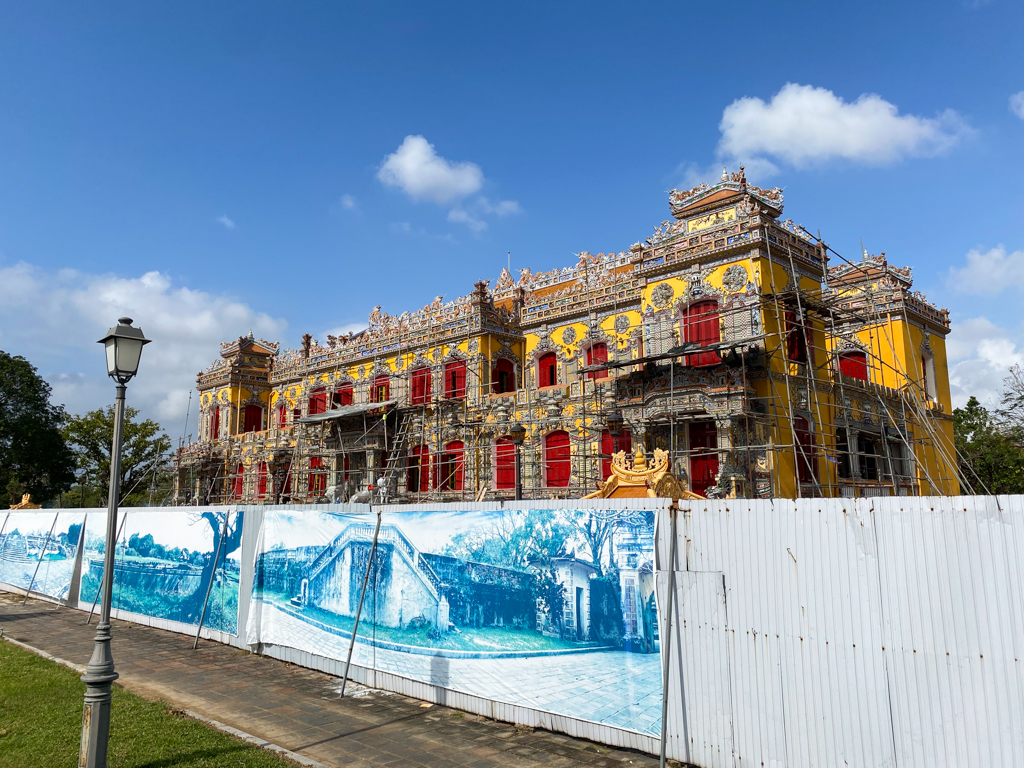 We then visited the Emperor’s Reading Room, an exquisite little building that miraculously survived the wars so it’s fairly intact. In fact, it was the only part of the Purple Forbidden City to escape damage during the French reoccupation of Huế in 1947. There are some exhibitions inside, but the symmetrical and colourful outside is the main attraction. The roof is covered in yin-yang mosaics. The exterior features poems by Emperor Khai Dinh on either side; the three chu nho characters above the main entrance translate as ‘Building of Great Peace’.
We then visited the Emperor’s Reading Room, an exquisite little building that miraculously survived the wars so it’s fairly intact. In fact, it was the only part of the Purple Forbidden City to escape damage during the French reoccupation of Huế in 1947. There are some exhibitions inside, but the symmetrical and colourful outside is the main attraction. The roof is covered in yin-yang mosaics. The exterior features poems by Emperor Khai Dinh on either side; the three chu nho characters above the main entrance translate as ‘Building of Great Peace’.
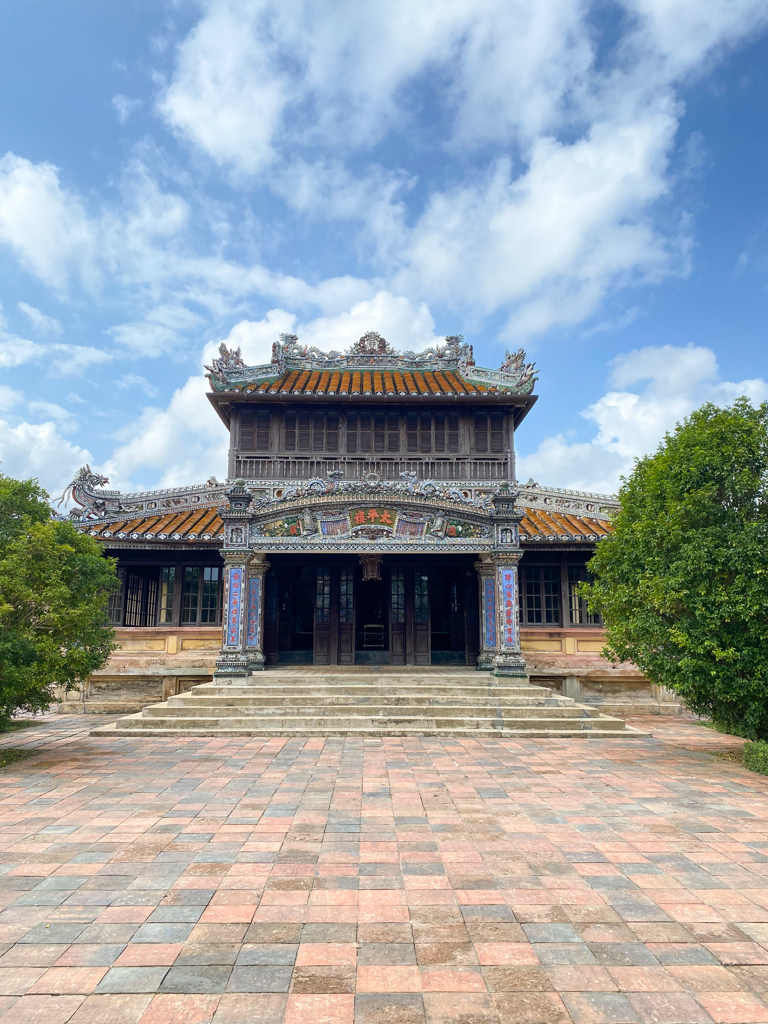
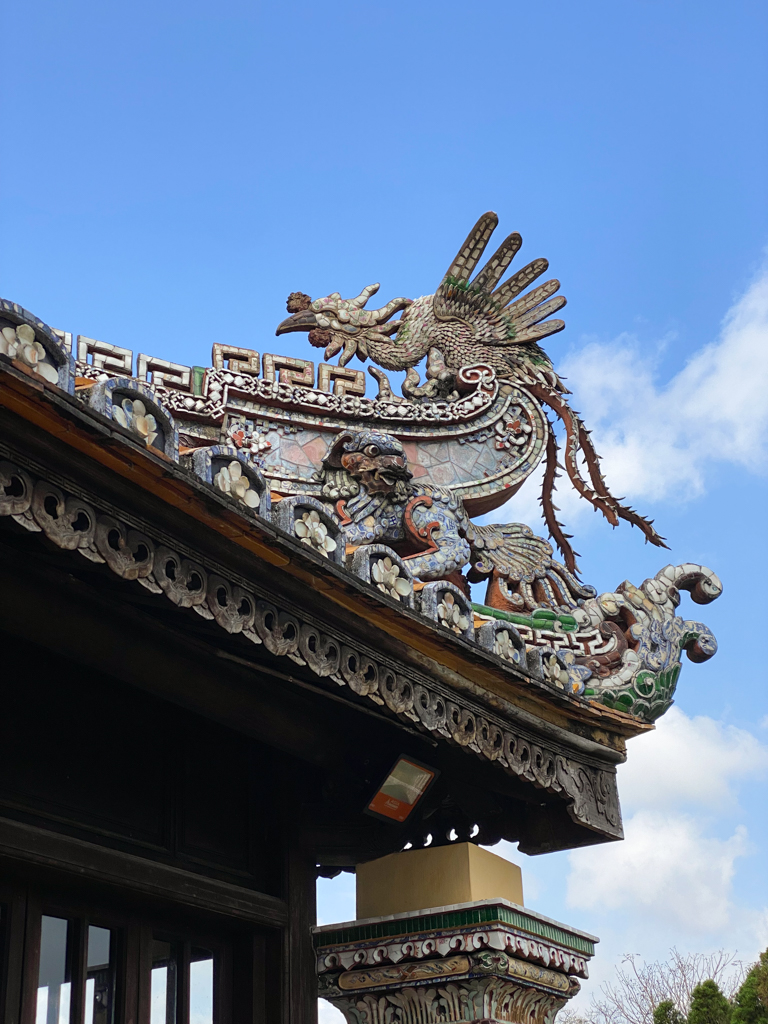
Our next stop was the Co Ha Gardens. These gardens were developed by the first four emperors of the Nguyen dynasty but fell into disrepair. There’s a lovely pavilion overlooking a lake in the centre and a viewpoint up a small path by a tree in the northeast corner. These gardens are wonderfully peaceful, though I can imagine if the sun was out it may get quite hot wandering around with very little shade!
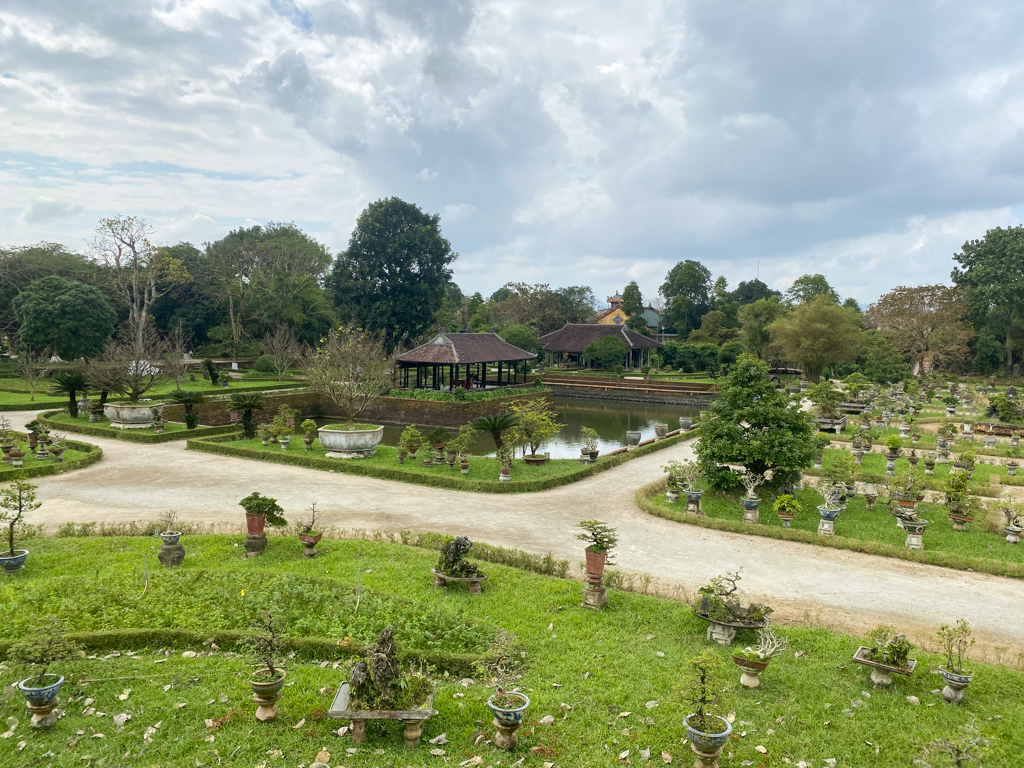 In the peaceful northwest corner, the Truong San Residence sees few visitors but is also a charming area. In 1844, Emperor Thieu Tri described this as one of Huế’s most beautiful spots. Unfortunately, this area was devasted by wartime damage. The residence is surrounded by a wall with a beautiful entrance gate and a winding moat just inside the area.
In the peaceful northwest corner, the Truong San Residence sees few visitors but is also a charming area. In 1844, Emperor Thieu Tri described this as one of Huế’s most beautiful spots. Unfortunately, this area was devasted by wartime damage. The residence is surrounded by a wall with a beautiful entrance gate and a winding moat just inside the area.
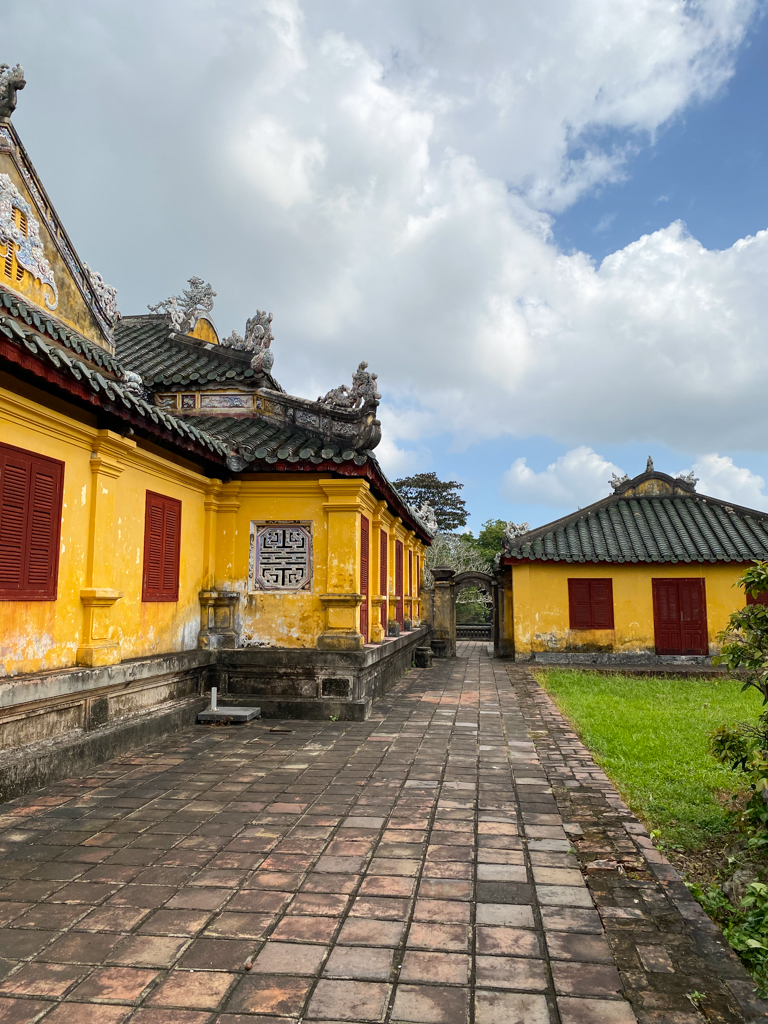
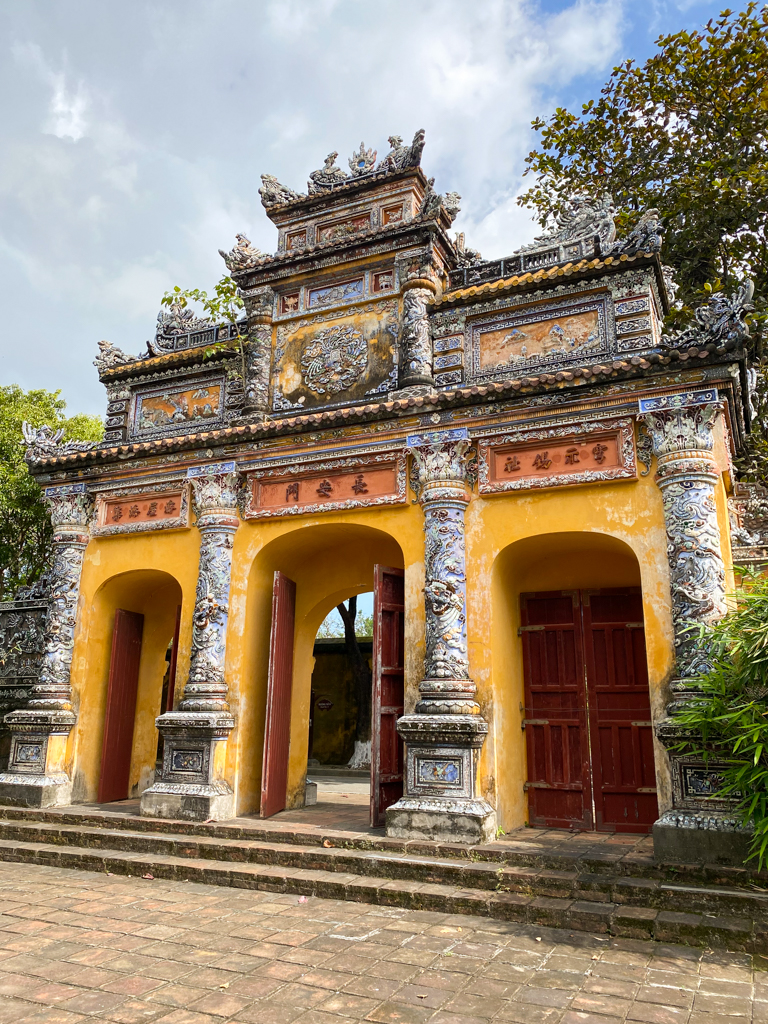
Up next is the stunning, partially ruined Dien Tho Residence (1804). It once comprised the apartments and audience hall of the Queen Mothers of the Nguyen dynasty. It has been mostly restored, though there are still signs of a large fire.
There’s a cafe within this complex and it’s a beautiful spot by a pond. In the right season, it’s apparently full of blooming lilies. We stopped for a drink and a little snack to take a break from all the exploring.
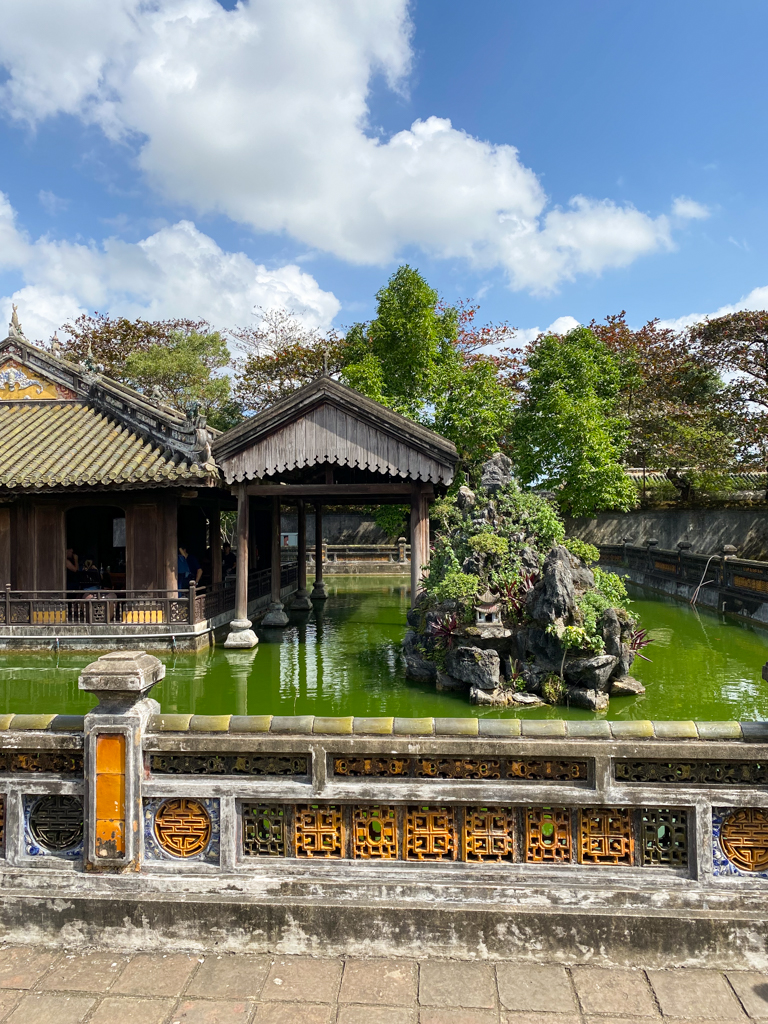
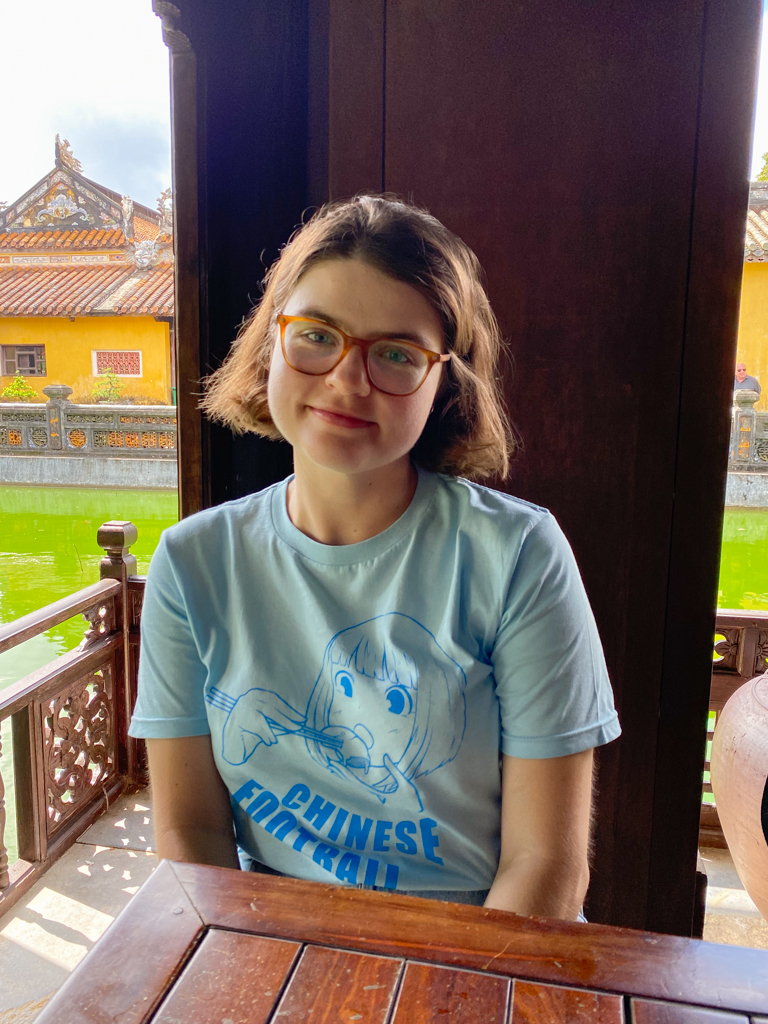
We then left the area to go to the southwest corner of the Imperial Enclosure. A very impressive walled complex is located here called the To Mieu Temple Complex. The imposing three-tiered Hien Lam Pavilion sits on the south side of the complex; it dates from 1824. On the other side of a courtyard is the solemn To Mieu Temple, housing shrines to each of the emperors, topped by their photos. Between these two temples are Nine Dynastic Urns (dinh) cast between 1835 and 1836, each dedicated to one Nguyen sovereign.
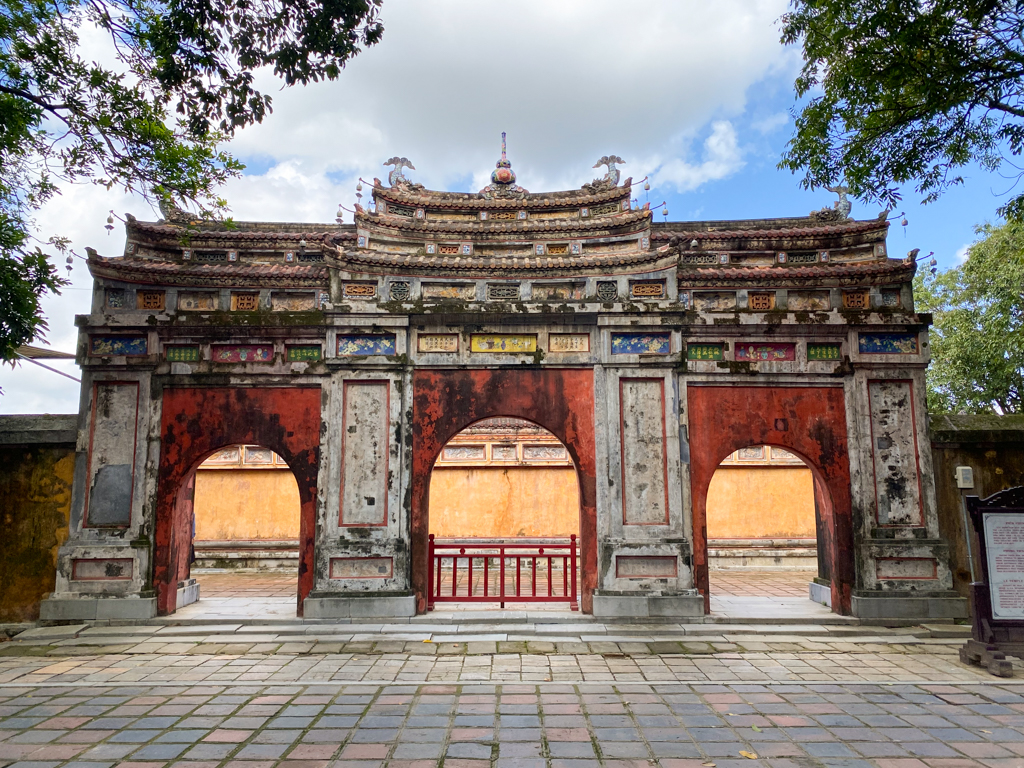
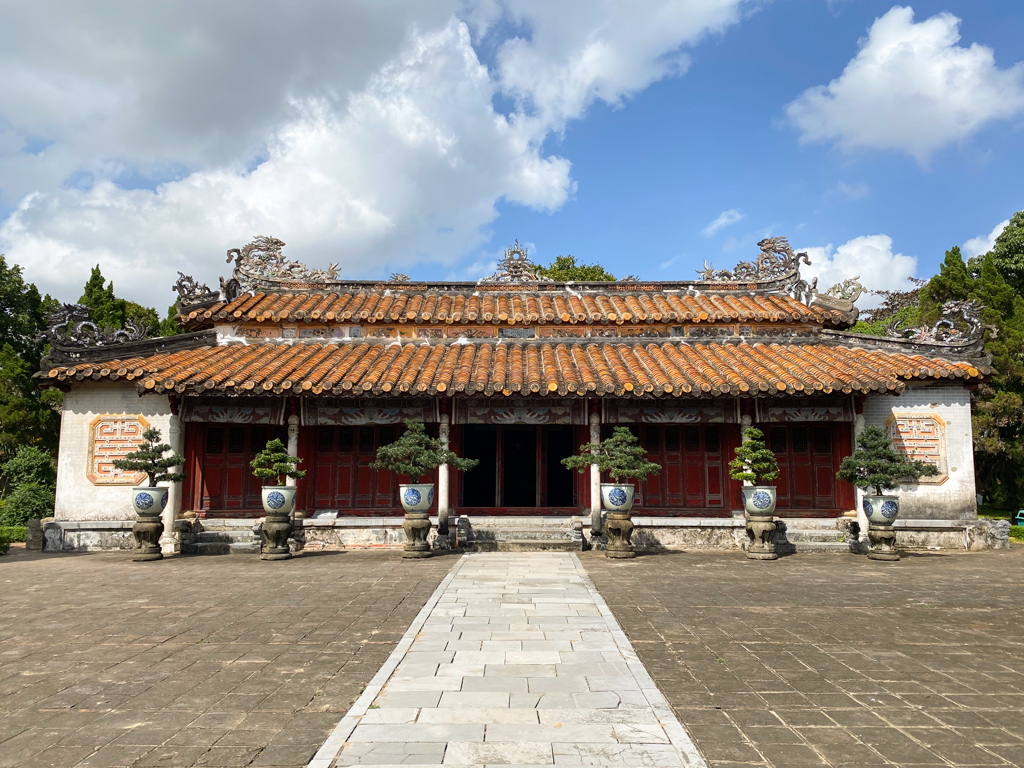
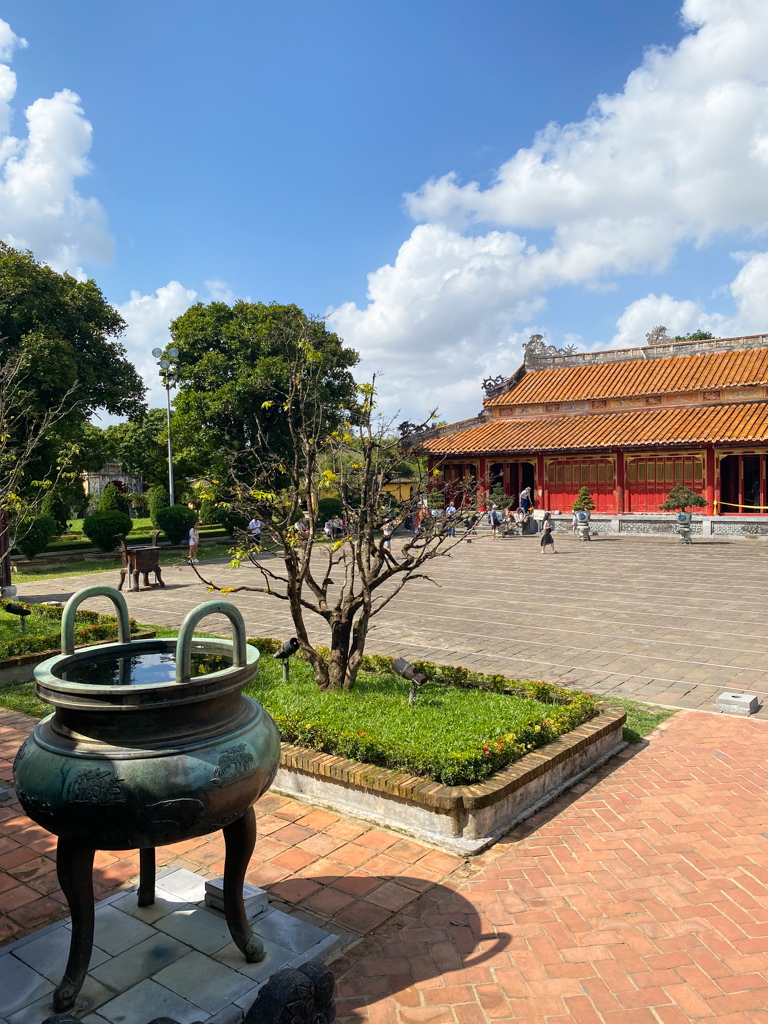
We left the Citadel and picked up our bikes to cycle to Con Hến, an islet in the middle of the Perfume River accessible only by a single bridge. The islet’s name translates to baby clam island. Its social-economical make-up mainly comprises generations’ worth of hến (baby clam) fisheries and restaurants selling hến-related specialities. So yes, it’s clam paradise (not for the clams, unfortunately).
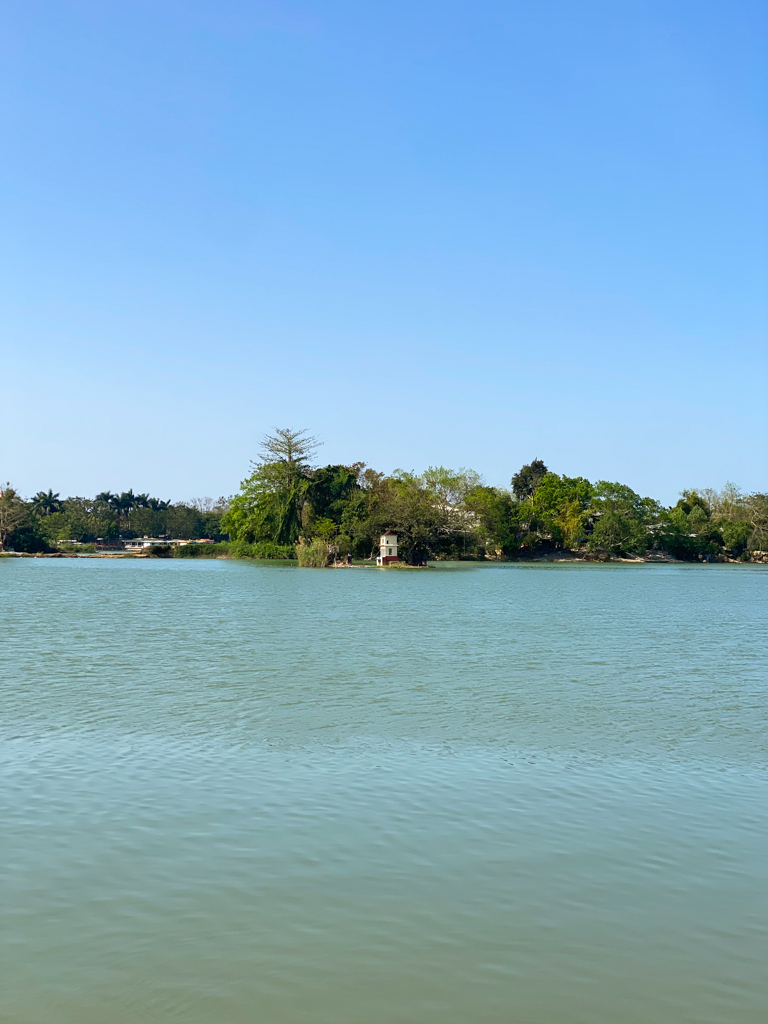
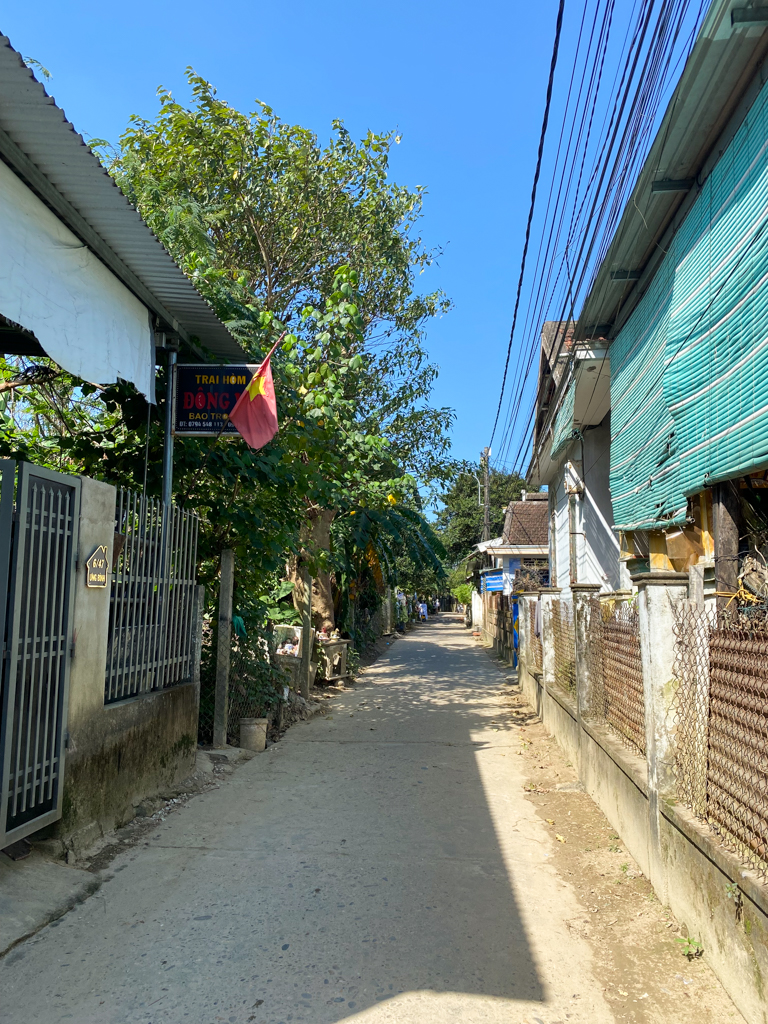
So it shouldn’t be a surprise that for lunch we decided to try these famous clams! There are so many restaurants that look identical and serve identical food, but we had done our research and so landed on a place called Cơm Hến Hoa Đông. Hến is most commonly served on top of rice (cơm hến) or rice vermicelli noodles (bún hến). But, here you could also get the baby clams with yellow wheat noodles (mỳ or mì hến), in a rice soup which is like a congee (cháo hến) or fried and served with a black sesame rice cracker (hến xào). We both had the rice noodle version, which comes with the broth on the side.
It’s traditional to have this dish with chè bắp. I’ve discussed chè in my blog posts on Can Tho and Hoi An. This type of chè is made with corn, so it’s essentially a sweet corn pudding. Everything was so yummy. The ladies running the place don’t speak English, but a guy sitting next to us kindly helped us order. He even ordered a fruit smoothie for us (at no charge to us) just as a nice gesture.
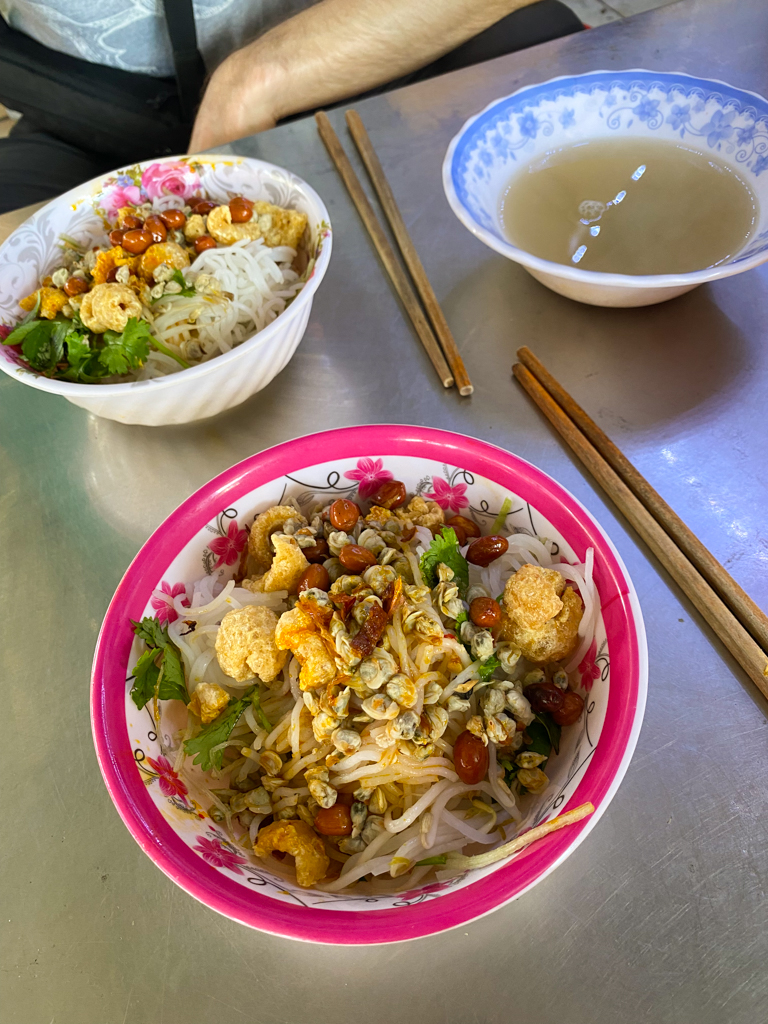
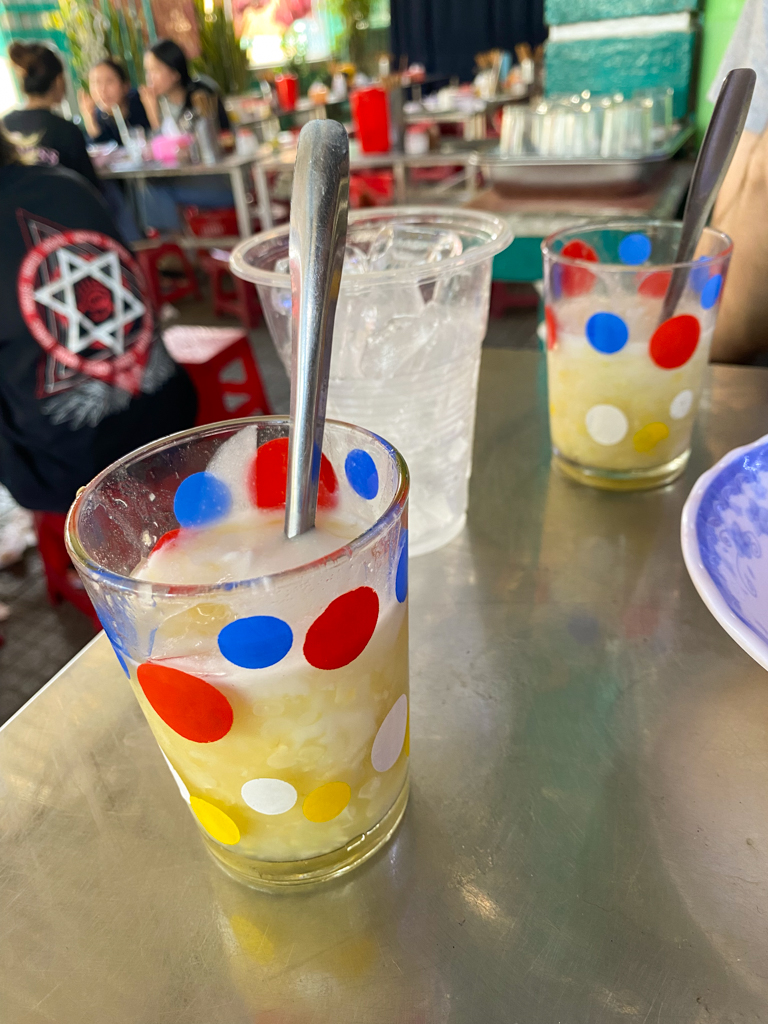
We cycled back to our accommodation to drop off our bikes. By this time it was around 3:30pm and we decided to take a break and deal with some travel planning and admin. We went to a cafe really close by called đa:mê cafe for some coffee and a snack. This cafe ended up being my absolute favourite in all of Vietnam! It’s also where I began to learn more about Vietnamese coffee. As I mentioned in my post covering our first day in Ho Chi Minh City, Vietnam is the second largest producer of coffee in the world but produces predominantly Robusta coffee. Robusta was discovered in the Belgian Congo in the late 19th century and it was found to be able to grow and fruit at lower altitudes than Arabica plants. It could also grow in higher temperatures and was more resistant to disease. However, it’s very well-known that Robusta is far inferior to Arabica in taste. As James Hoffmann writes in his book The World Atlas of Coffee, Robusta has “a woody, burnt-rubber quality in the cup”. But, it’s cheap and easy to grow, so 40% of the world’s coffee produced each year is Robusta.
Up until this point we had just tried regular cà phê which typically means drip coffee. It’s made by letting ground coffee slowly drip through a filter into a glass, which sometimes can also be filled with sweetened condensed milk and/or ice. When I first landed in Vietnam I started with hot drip coffee with no sugar and it tasted, frankly, pretty awful. It’s no wonder that Vietnamese coffee is typically made with sweetened condensed milk. It staves off that bitter taste of the coffee. You can get Arabica in Vietnam, but it’s definitely not the mainstream and you wouldn’t see it with classic, fun Vietnamese drinks.
 We were curious about these fun creations, so at the cafe, we ordered two types of sweet coffee drinks: cà phê muối (coffee with salted cream) and cà phê trứng muối (coffee with salted egg cream). The salted cream coffee was absolutely amazing. It originates from Huế and this blend combines Robusta coffee beans with a subtle touch of salt, striking a delicate balance between bitter and sweet reminiscent of indulgent salted caramel. Normally the cream is served on top, but this cafe gave me a glass of cream and the coffee separately to pour into the cream. The cream had this amazing texture that I didn’t find anywhere else in Vietnam. I dream of it still! The coffee with salted egg cream is actually a mix of two types of coffee drinks, one being the salted cream one, and the other being egg coffee. Egg coffee was invented in Hanoi in the 1940s when sugar and milk prices were soaring. Mr. Giang, the founder of Giang Cafe in Hanoi, turned to egg yolks, inspired by the cappuccino. This substitution birthed a rich, golden cream atop a robust coffee base, knitting bitter notes with the smooth richness of eggs, delicately sweetened with honey. The version here at the cafe took that and mixed it with salt to create a decadent drink, with a hint of salt. We liked this drink too, but it is quite intense! We also had a slice of cheesecake, because, well, why not?
We were curious about these fun creations, so at the cafe, we ordered two types of sweet coffee drinks: cà phê muối (coffee with salted cream) and cà phê trứng muối (coffee with salted egg cream). The salted cream coffee was absolutely amazing. It originates from Huế and this blend combines Robusta coffee beans with a subtle touch of salt, striking a delicate balance between bitter and sweet reminiscent of indulgent salted caramel. Normally the cream is served on top, but this cafe gave me a glass of cream and the coffee separately to pour into the cream. The cream had this amazing texture that I didn’t find anywhere else in Vietnam. I dream of it still! The coffee with salted egg cream is actually a mix of two types of coffee drinks, one being the salted cream one, and the other being egg coffee. Egg coffee was invented in Hanoi in the 1940s when sugar and milk prices were soaring. Mr. Giang, the founder of Giang Cafe in Hanoi, turned to egg yolks, inspired by the cappuccino. This substitution birthed a rich, golden cream atop a robust coffee base, knitting bitter notes with the smooth richness of eggs, delicately sweetened with honey. The version here at the cafe took that and mixed it with salt to create a decadent drink, with a hint of salt. We liked this drink too, but it is quite intense! We also had a slice of cheesecake, because, well, why not?
About an hour later we decided to go for a walk along the Perfume River to see the sunset. The boardwalk along the river is really lovely to walk down. It’s also nice to see all the locals out and about and enjoying the cooler evening.
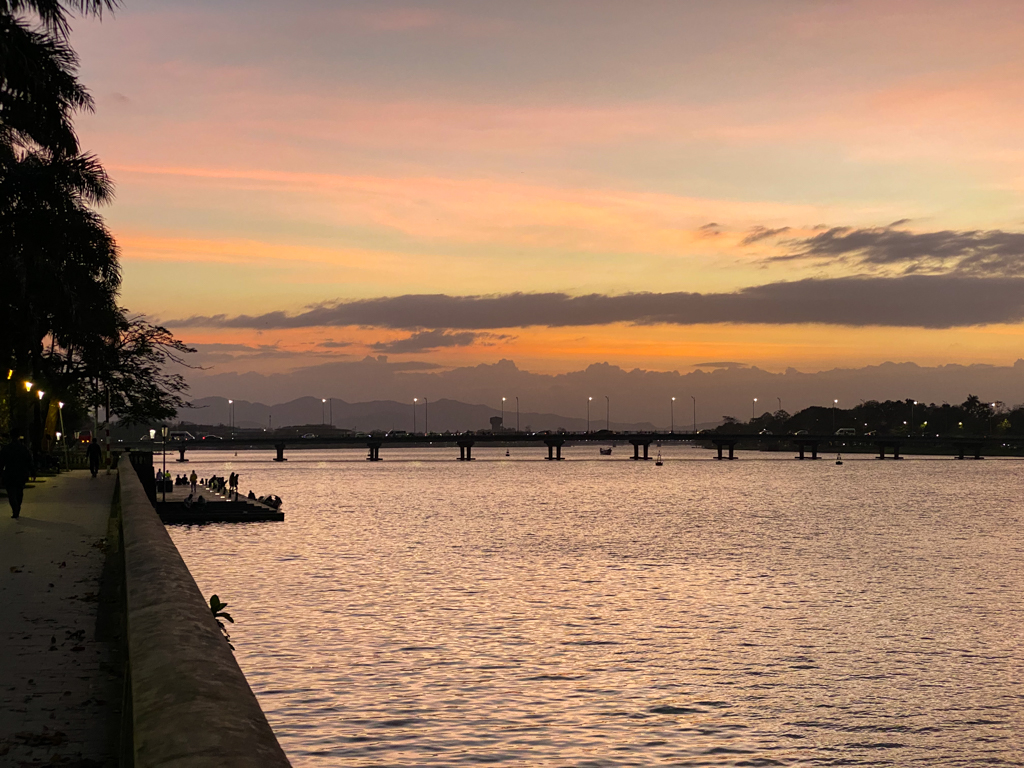 Victor had said earlier in the day he was really craving a bánh mì, so I told him why not get one as a pre-dinner snack. We went to Bánh Mì Trường Tiền O Tho where he got bánh mì đặc biệt, a typical version of banh mi from Ho Chi Minh City. It’s filled with pate, roasted pork, sliced ham, Vietnamese sausage, Chinese sausage and Vietnamese meatballs (called xíu mái). He said it was really intense but pretty good.
Victor had said earlier in the day he was really craving a bánh mì, so I told him why not get one as a pre-dinner snack. We went to Bánh Mì Trường Tiền O Tho where he got bánh mì đặc biệt, a typical version of banh mi from Ho Chi Minh City. It’s filled with pate, roasted pork, sliced ham, Vietnamese sausage, Chinese sausage and Vietnamese meatballs (called xíu mái). He said it was really intense but pretty good.
For dinner, we went to Quán Bà Hòa, a hole in the wall that serves all sorts of Huế specialities. We ordered two types of rice cakes, bánh bèo khay and bánh bột lọc (two types we had tried the night before at Maison Trung). Both were delicious! I got cơm hến to try the rice version of this dish. Victor got bún bò huế, a rice noodle dish with sliced beef, chả lụa (Vietnamese pork sausage), and sometimes pork knuckles. But, the version here had so much meat! It also had chicken liver, bloodcake, crab, and several other cuts of beef. As Victor later joked to his parents, they gave him half a cow! We very much enjoyed this place and would highly recommend it.
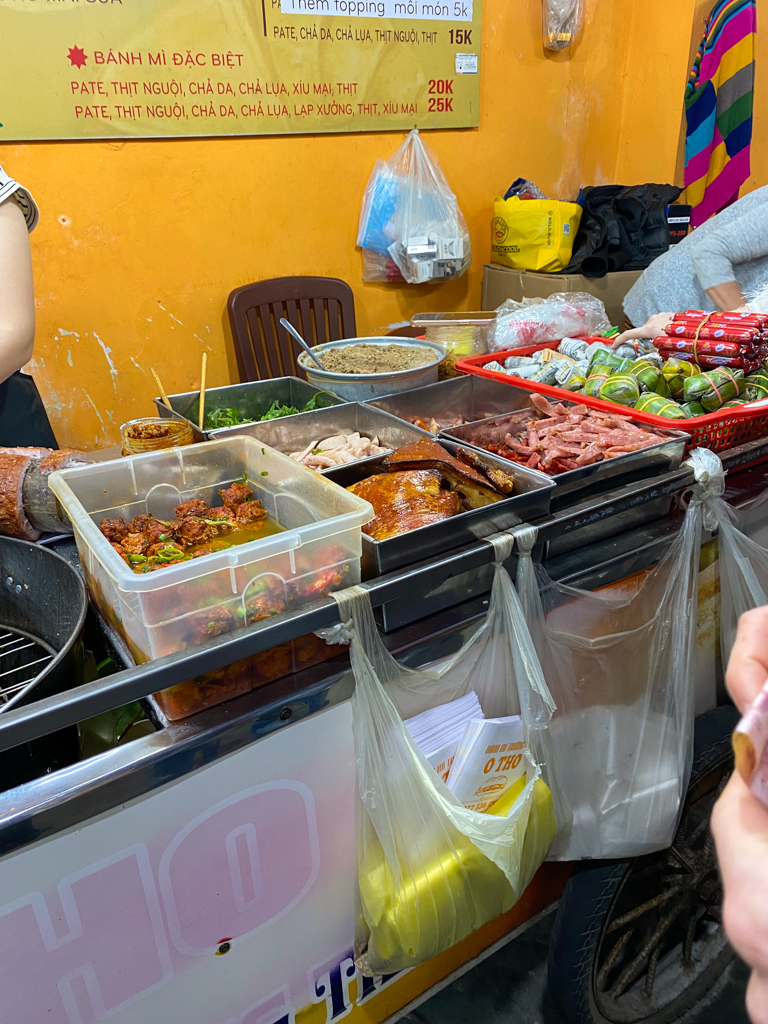
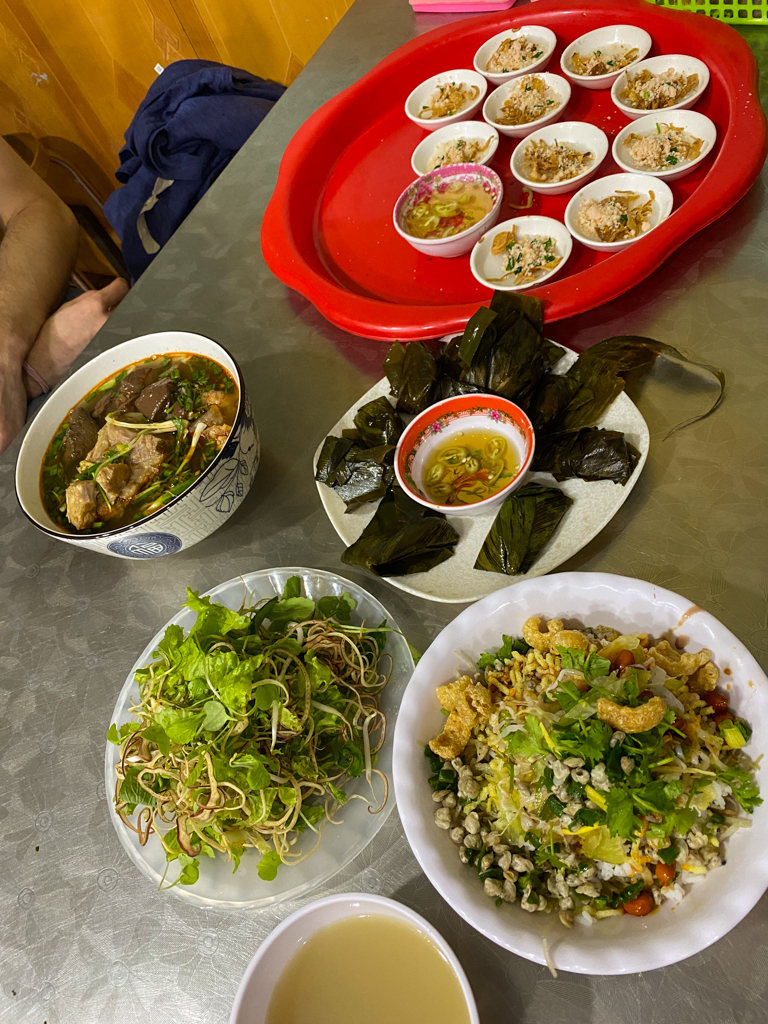
As we were walking back to our accommodation we saw a store with people dressed in dragon costumes. We decided to stick around to see what would happen and to our delight, we got to see a traditional lion and dragon dance. Businesses in China and Vietnam typically ask dance troupes to perform this dance outside their premises to attract prosperity and good fortune. Once the dance was over, we ventured inside to see what all the fuss was all about it.
Turns out this is a craft shop (Văn Phòng Làng Nghề Huế) in the sense that it sells crafts from Huế and the surrounding area. For the opening, they had artisans and workshops showing you how to make various crafts, from bamboo weaving and incense stick making to lantern painting and flower arranging. It’s a really neat store and a great place to buy souvenirs. We bought some bamboo trays, mè xửng (sesame candy), and Huế royal tea.

 We dropped off all of our goodies back at our accommodation and then went out for a drink. We chose a random bar along the street with a free table and ordered two bottles of Huda. It’s a lager beer produced and bottled in Huế, and the cheap alcoholic drink of choice for most people as far as we could tell.
We dropped off all of our goodies back at our accommodation and then went out for a drink. We chose a random bar along the street with a free table and ordered two bottles of Huda. It’s a lager beer produced and bottled in Huế, and the cheap alcoholic drink of choice for most people as far as we could tell.
 The next morning we got up and asked our accommodation to help us organise a boat ride down the Perfume River to visit Thien Mu Pagoda. We had read online before our trip that it’s usually always best to organise tourist activities and transfer through your accommodation as oftentimes they can get you a better, or at least a legitimate, trustworthy option. Unfortunately, we did not have a good experience with the boat. The boat attendant laid out a scarf with a bunch of souvenirs to purchase. She handed me a laminated poster, explaining that she needed help and would really benefit from any purchase. I decided to look through her wares and bought two bookmarks. She was incredibly pushy the whole time, and once I had bought something became extremely rude (I guess because she couldn’t get any more money out of me). Our accommodation host had said the pagoda visit would be for an hour. However, our boatman and boat attendant insisted that we could only stay for 15-20 minutes. We demanded at least 30 minutes, but we couldn’t push too hard as we were worried we would lose our ride!
The next morning we got up and asked our accommodation to help us organise a boat ride down the Perfume River to visit Thien Mu Pagoda. We had read online before our trip that it’s usually always best to organise tourist activities and transfer through your accommodation as oftentimes they can get you a better, or at least a legitimate, trustworthy option. Unfortunately, we did not have a good experience with the boat. The boat attendant laid out a scarf with a bunch of souvenirs to purchase. She handed me a laminated poster, explaining that she needed help and would really benefit from any purchase. I decided to look through her wares and bought two bookmarks. She was incredibly pushy the whole time, and once I had bought something became extremely rude (I guess because she couldn’t get any more money out of me). Our accommodation host had said the pagoda visit would be for an hour. However, our boatman and boat attendant insisted that we could only stay for 15-20 minutes. We demanded at least 30 minutes, but we couldn’t push too hard as we were worried we would lose our ride!
 Nonetheless, we tried to put aside our frustrations and enjoy the pagoda. Built on a small hill overlooking the Song Huong (Perfume River), 4km southwest of the Citadel, this seven-storey pagoda is an icon of Vietnam and as potent a symbol of Huế as the Citadel. The 21m-high octagonal tower, Thap Phuoc Duyen, was constructed under the reign of Emperor Thieu Tri in 1844. Each of its storeys is dedicated to a manushi-buddha (a Buddha that appeared in human form).
Nonetheless, we tried to put aside our frustrations and enjoy the pagoda. Built on a small hill overlooking the Song Huong (Perfume River), 4km southwest of the Citadel, this seven-storey pagoda is an icon of Vietnam and as potent a symbol of Huế as the Citadel. The 21m-high octagonal tower, Thap Phuoc Duyen, was constructed under the reign of Emperor Thieu Tri in 1844. Each of its storeys is dedicated to a manushi-buddha (a Buddha that appeared in human form).
Thien Mu Pagoda was originally founded in 1601 by Nguyen Hoang, governor of Thuan Hoa province. Over the centuries its buildings have been destroyed and rebuilt several times. Since the 1960s it has been a hotspot for political demonstrations.
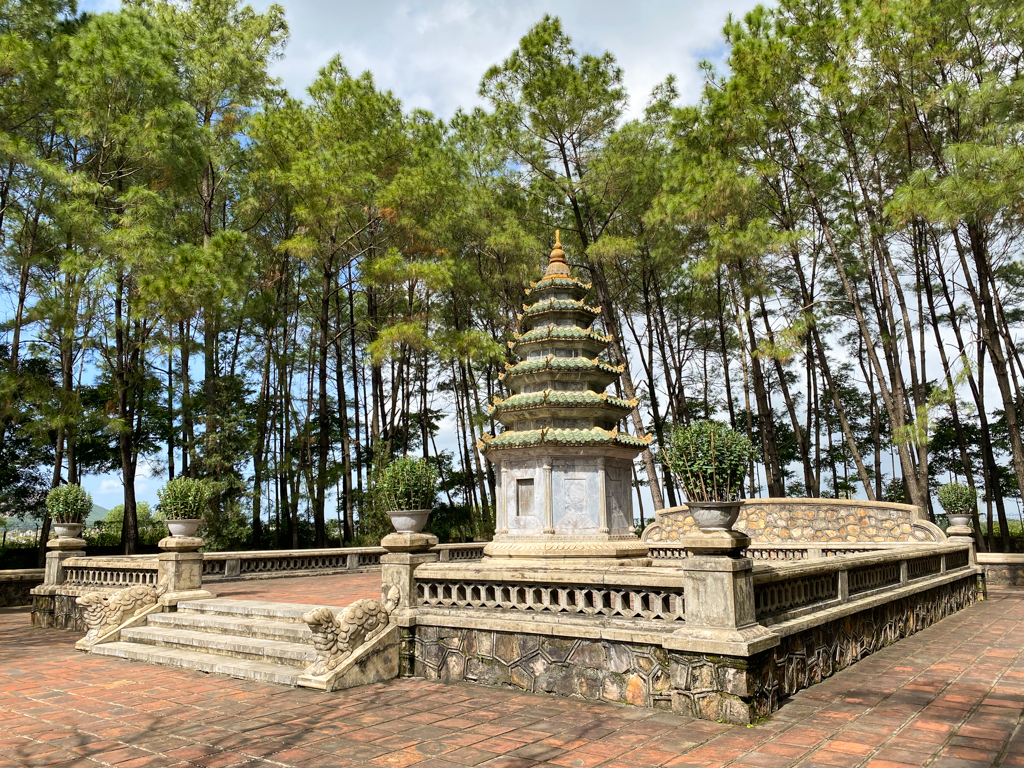
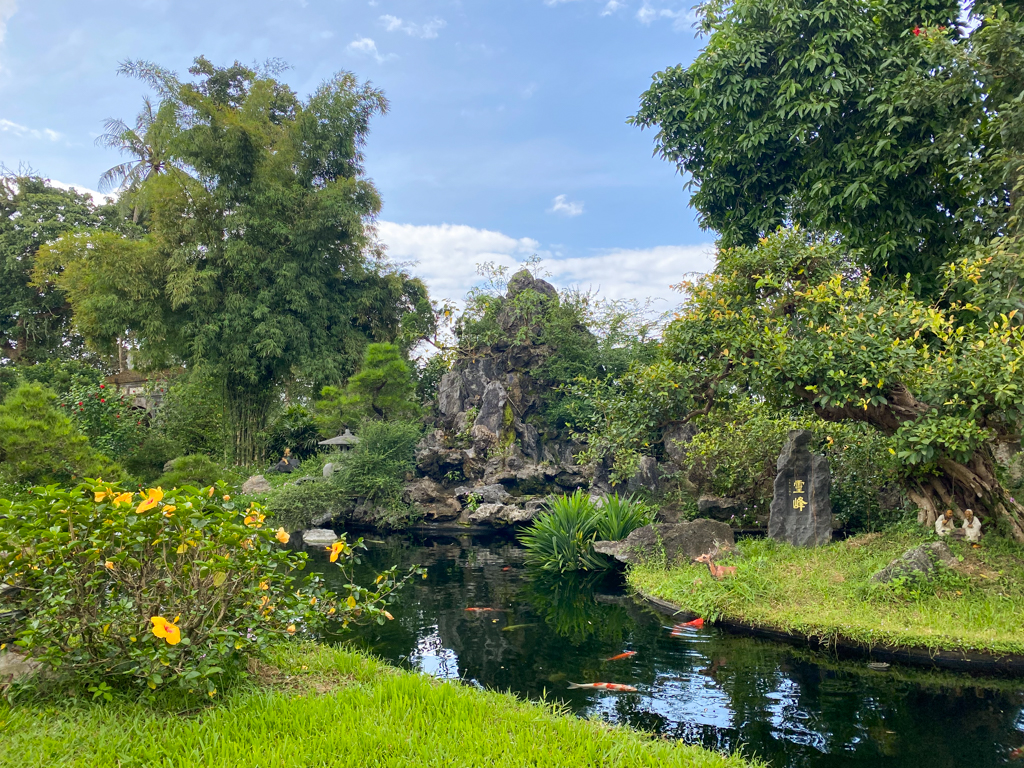
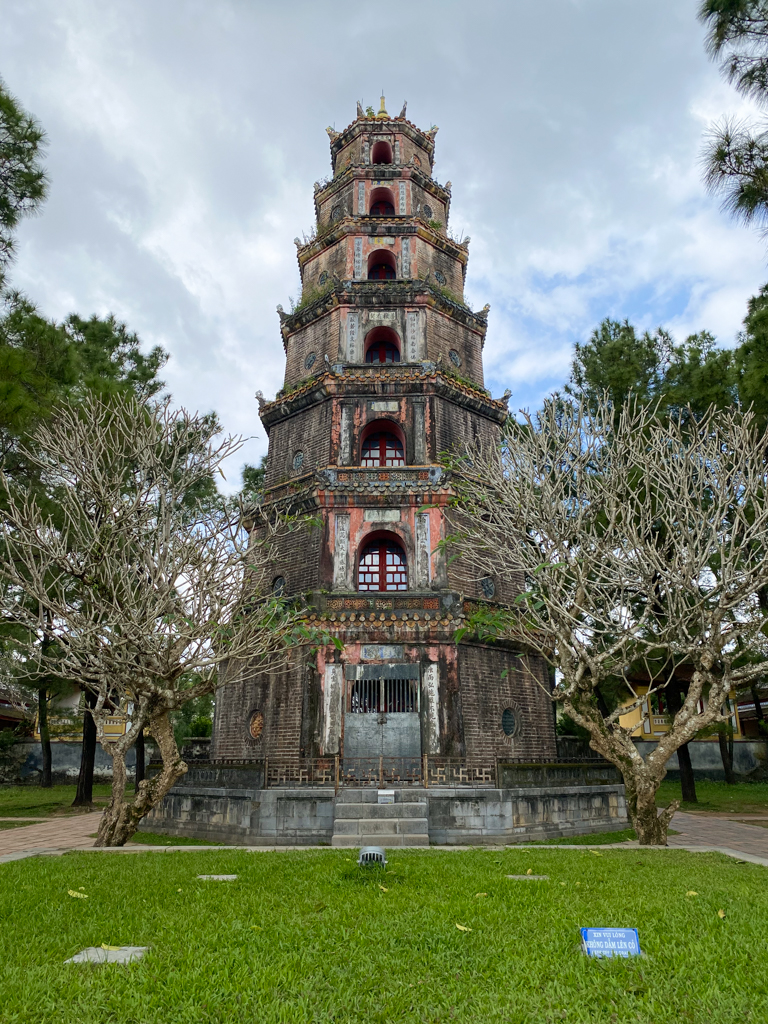
We took the boat back to downtown Huế. We informed our accommodation about the boat ride situation and he was absolutely mortified. He was truly embarrassed and apologised profusely. He called the tour operator and got us a significant discount. At least we got something!
For lunch, we went to a restaurant nearby called Madam Thu 2. We had slightly lower expectations because we knew this was a touristy choice. What we didn’t realise is that this second location is really meant for organised tourist groups. We laughed to ourselves as tour guide after tour guide guided their group into the restaurant. But I will say, the food was actually pretty good. We ordered the bánh ít, another type of sticky rice cake with shrimp. We also got the bánh khoái (that Huế-style crispy pancake with fillings) and tôm sốt chanh dây (grilled shrimp with passion fruit sauce). For dessert, we had complimentary passion fruit and watermelon.

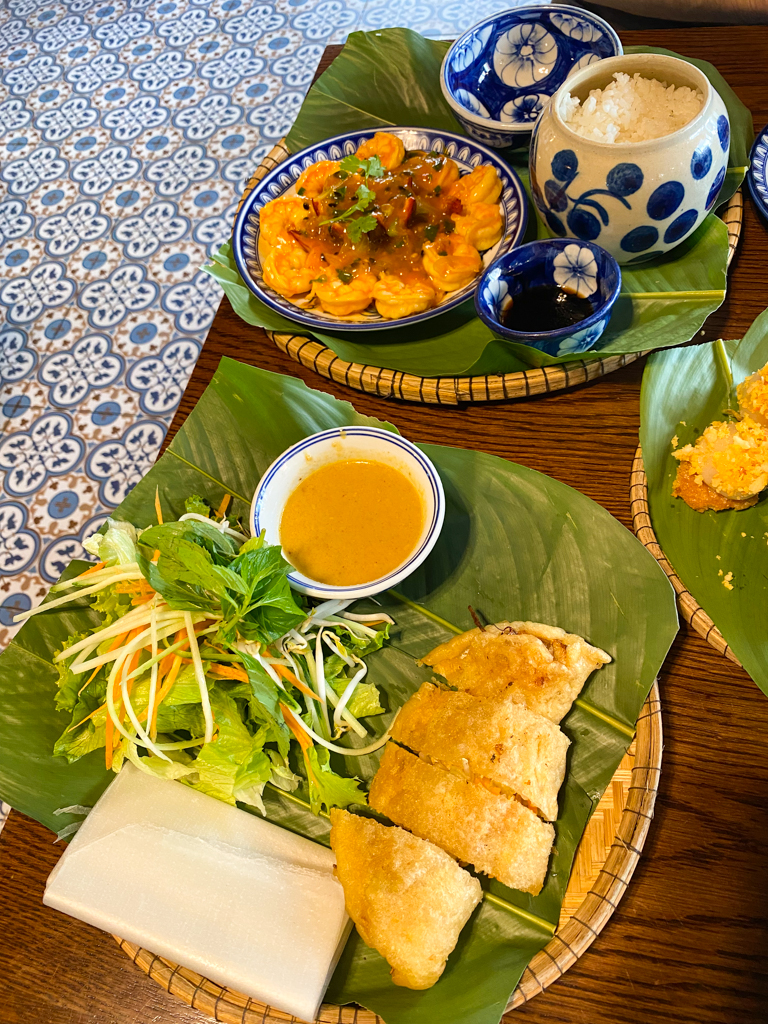
We headed back to our accommodation to pick up our bags to embark on the next chapter of our grand adventure! We took a Grab to the train station and waited for our train to Dong Hoi. The train arrived on time and once we sat down, we had to ensure three hours of absolute chaos and noise! There was never a moment of silence. Several kids were running around the train and jumping on the seats. And, cart upon cart of food kept rolling by. Anything you can imagine passed by, the pho cart, the sandwich cart, the snacks cart, and so on.
 Once we reached Dong Hoi we were picked up by a car branded with our accommodation’s logo which drove us to Phong Nha, our next destination. We arrived at our accommodation around 7:30pm, where we were given tea and all the information we needed to decide on our itinerary for the next three days. While it was sad to leave Huế, we were really excited for a change of pace and I can’t wait to tell you all about it!
Once we reached Dong Hoi we were picked up by a car branded with our accommodation’s logo which drove us to Phong Nha, our next destination. We arrived at our accommodation around 7:30pm, where we were given tea and all the information we needed to decide on our itinerary for the next three days. While it was sad to leave Huế, we were really excited for a change of pace and I can’t wait to tell you all about it!
What do you think of the royal city of Huế? What captures your attention? The historical buildings, the food, or the river?

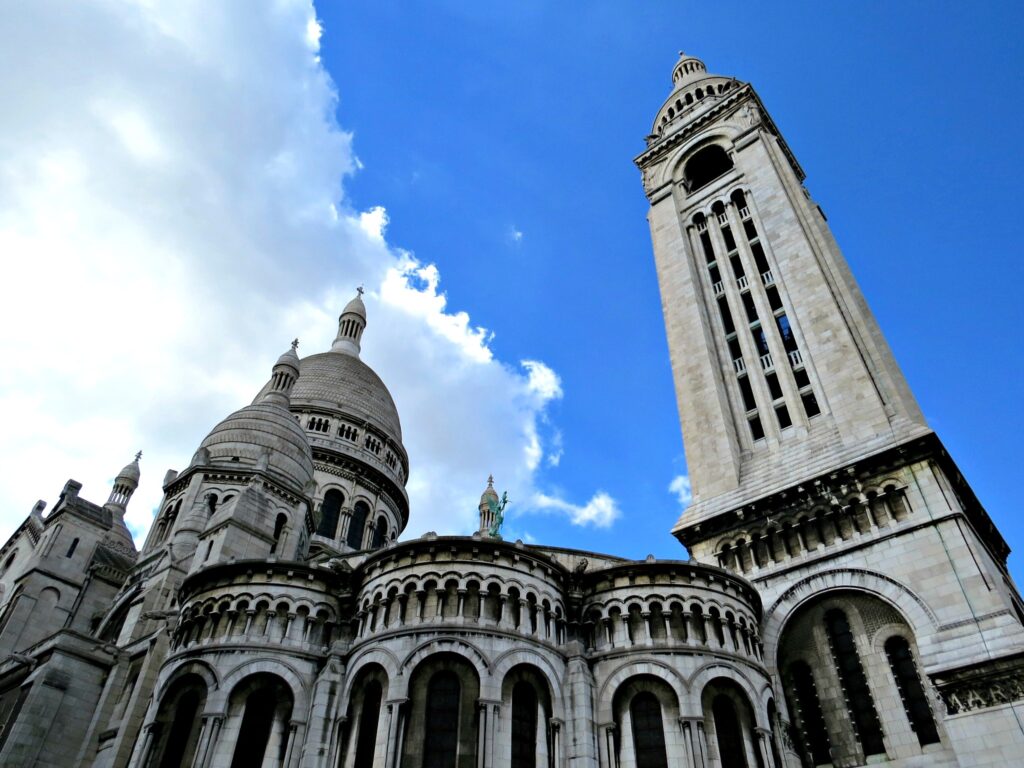


No Comments